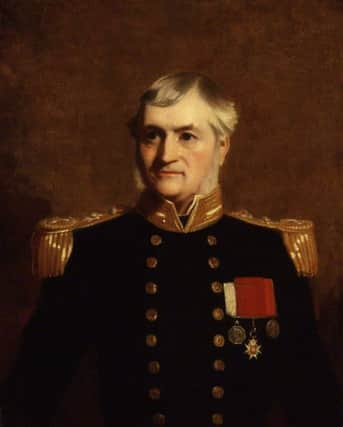Three polar explorers from Ireland provided furniture for the White House


After losing the race to be first to the South Pole, Captain Scott’s 17-month trek ended tragically in a tent, battered by relentless gales and blizzards, on March 29, 1912.
Inniskilling Dragoon Captain ‘Titus’ Oates died towards the end of Scott’s beleaguered but heroic attempt to win the race.
Advertisement
Hide AdAdvertisement
Hide AdOther polar explorers with Irish connections emerged from News Letter readers’ notes to Roamer, including Ernest Shackleton from County Kildare, Banbridge’s Francis Crozier, and Kerry-man Tom Crean who was one of Scott’s most experienced team-leaders.
It seems that these Polar-Irish connections are just the tip of an iceberg!
Vice Admiral Sir Leopold McClintock from Dundalk, whose family tree is well-rooted in County Antrim, has a channel in the Arctic named in his honour.
Some of Sir Leopold’s land and sea expeditions in the mid-1800s were shared on this page last week, and we have more introductions to historic, ice-bound Irishmen today: Captain Henry Kellet from Tipperary, George Mecham from Cobh, and Captain Robert McClure from Wexford.
Advertisement
Hide AdAdvertisement
Hide AdRather aptly, as the world waits to know who’ll move into the White House, there’s a big wooden desk awaiting the next American President which featured profoundly in the three Irish Polar explorers’ expeditions!
Roamer has been referred to a number of books about Ireland’s multitude of polar adventurers, one recounting 12-year-old Leopold McClintock’s first ship in 1831 - the Frigate Samarang, on the Thames.
The young trainee officer noted “breakfast was at eight, consisting of cocoa and biscuit; dinner was at 12, salt junk (hard salt beef eaten at sea) or pork with biscuit, and plum duff on ‘duff days’, sometimes pumpkin pie; tea at five. Allowances of rum were taken up, but youngsters seldom touched it.”
As his career progressed to colder lands, Leopold’s memoirs become much less domesticated, recalling fearful ice flows, gale-swept sledge treks, frostbitten crewmen, horrifying shipwrecks, accidents, life-threatening illnesses and virtual starvation.
Advertisement
Hide AdAdvertisement
Hide Ad‘Seek the Frozen Lands’, a book by adventurer, explorer, mountaineer and author Frank Nugent, tells of Irish polar explorers from 1740 to 1922.
Published by the Collins Press, Nugent’s gripping narrative introduces Arthur Dobbs from Carrickfergus, the first Irishman to make a significant contribution to Arctic exploration in the 18th century by initiating and supporting two voyages in search of the North-West passage.
The book recounts Edward Bransfield of Ballinacurra, Cork, one of the earliest Irish explorers to put his name on the charts when he became the first man to sight mainland Antarctica.
The White House’s aforementioned Presidential desk takes us back to 1852 when H.M.S Resolute and four other ships, all commanded by Nova Scotia’s Sir Edward Belcher, sailed to the Arctic in search of Sir John Franklin and his crew, lost during an attempt to navigate the Northwest Passage.
Advertisement
Hide AdAdvertisement
Hide AdH.M.S. Resolute was captained by Tipperary’s Henry Kellett. The vessel’s first mate was George Mecham from Queenstown, now Cobh.
Dundalk’s Francis Leopold McClintock commanded one of the other ships in the small, polar-bound fleet.
There were more Irish connections!
While Sir John Franklin’s lost expedition was the main reason for the voyage, Kellett, Mecham and McClintock were keen to find the whereabouts of Wexford-born Robert McClure, another Northwest Passage explorer who’d disappeared.
On one of his earlier trips to the region in 1851, McClintock had scraped a message on a stone on Melville Island on the Arctic archipelago which had been discovered a year later by the hopelessly ice-stranded McClure.
Advertisement
Hide AdAdvertisement
Hide AdThe Wexford explorer had been scouring the Island for provisions and was greatly surprised (and impressed!) to see a message from a fellow-Irishman in such desolate surroundings!
McClure left another note, detailing his crew’s position, which was later discovered by Mecham!
In ‘Seek the Frozen Lands’ Frank Nugent notes “It is a remarkable fact that on the northern polar edges of the then known world, a note left by Dundalk-man McClintock in 1851 was found by Wexford man McClure in April 1852, whose note was in turn found by Mecham, that intrepid Cobh man, in the autumn of that year.”
McClure was rescued, and went on to be first to circumnavigate the Americas, and to transit the Northwest Passage.
Advertisement
Hide AdAdvertisement
Hide AdThey never found Sir John Franklin, but Kellett, Mecham, and McClintock mapped vast, frozen and unknown Polar territories and stored provisions in desolate depots for future explorers.
But at the end of 1853 H.M.S Resolute was badly damaged in a storm and, along with three of the other four ships, became trapped in ice.
Their captains and crews were happy to wait for the summer thaw, but Commander Belcher ordered the ships to be abandoned, and brought his men home on the one ship that wasn’t ice-bound.
When the crewless H.M.S Resolute drifted away from the melting ice an American whaling ship took her in tow.
Advertisement
Hide AdAdvertisement
Hide AdThe government in Washington returned the ship to Britain, and when it was decommissioned Queen Victoria ordered that several desks should be made from her timber.
One was presented to the White House and the so-called Resolute Desk remains as one of the Oval Office’s most cherished furnishings.
Forever confirming that Irish ice are smiling!
Full details of Race to the End of the Earth are at www.titanicbelfast.com